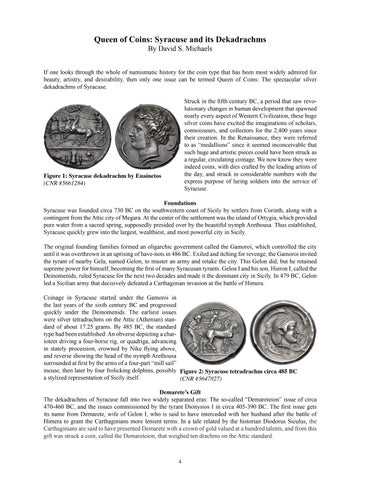Queen of Coins: Syracuse and its Dekadrachms By David S. Michaels
If one looks through the whole of numismatic history for the coin type that has been most widely admired for beauty, artistry, and desirability, then only one issue can be termed Queen of Coins: The spectacular silver dekadrachms of Syracuse. Struck in the fifth century BC, a period that saw revolutionary changes in human development that spawned nearly every aspect of Western Civilization, these huge silver coins have excited the imaginations of scholars, connoisseurs, and collectors for the 2,400 years since their creation. In the Renaissance, they were referred to as “medallions” since it seemed inconceivable that such huge and artistic pieces could have been struck as a regular, circulating coinage. We now know they were indeed coins, with dies crafted by the leading artists of the day, and struck in considerable numbers with the express purpose of luring soldiers into the service of Syracuse.
Figure 1: Syracuse dekadrachm by Euainetos (CNR #5661284)
Foundations Syracuse was founded circa 730 BC on the southwestern coast of Sicily by settlers from Corinth, along with a contingent from the Attic city of Megara. At the center of the settlement was the island of Ortygia, which provided pure water from a sacred spring, supposedly presided over by the beautiful nymph Arethousa. Thus established, Syracuse quickly grew into the largest, wealthiest, and most powerful city in Sicily. The original founding families formed an oligarchic government called the Gamoroi, which controlled the city until it was overthrown in an uprising of have-nots in 486 BC. Exiled and itching for revenge, the Gamoroi invited the tyrant of nearby Gela, named Gelon, to muster an army and retake the city. This Gelon did, but he retained supreme power for himself, becoming the first of many Syracusan tyrants. Gelon I and his son, Hieron I, called the Deinomenids, ruled Syracuse for the next two decades and made it the dominant city in Sicily. In 479 BC, Gelon led a Sicilian army that decisively defeated a Carthaginian invasion at the battle of Himera. Coinage in Syracuse started under the Gamoroi in the last years of the sixth century BC and progressed quickly under the Deinomenids. The earliest issues were silver tetradrachms on the Attic (Athenian) standard of about 17.25 grams. By 485 BC, the standard type had been established: An obverse depicting a charioteer driving a four-horse rig, or quadriga, advancing in stately procession, crowned by Nike flying above, and reverse showing the head of the nymph Arethousa surrounded at first by the arms of a four-part “mill sail” incuse, then later by four frolicking dolphins, possibly Figure 2: Syracuse tetradrachm circa 485 BC a stylized representation of Sicily itself. (CNR #5647827) Demarete’s Gift The dekadrachms of Syracuse fall into two widely separated eras: The so-called “Demareteion” issue of circa 470-460 BC, and the issues commissioned by the tyrant Dionysios I in circa 405-390 BC. The first issue gets its name from Demarete, wife of Gelon I, who is said to have interceded with her husband after the battle of Himera to grant the Carthaginians more lenient terms. In a tale related by the historian Diodorus Siculus, the Carthaginians are said to have presented Demarete with a crown of gold valued at a hundred talents, and from this gift was struck a coin, called the Demareteion, that weighed ten drachms on the Attic standard.
4
